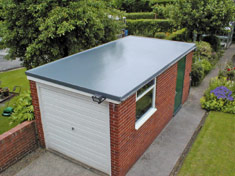How to Use Polyester Resin
This entry was posted on Mar 19, 2014 by speedy-bedUsing polyester resin for an application such as a glass fibre roof covering can generally be used as follows. First step must be to only attempt this job on a dry day with the surface your applying the resin to dry as well as any boards being laid down first. Damp boards will cause the fibreglass to delaminate, also avoid doing this at sunrise to avoid any damp air.
At your discretion you can either board over any existing surface or remove the old roof and replace with new boards depending on your budget and condition of the old surface. If your laying new boards then leave a 1/8” gap to allow for expansion. Its generally recommended to use boards at least ¾” thick, and not to fibreglass directly over existing felt roofs. If you have to fibreglass directly onto concrete or asphalt you must use a G4 polyurethane varnish first to prevent the alkaline attacking the resin (read the tin instructions first) and apply the G4 to the underside of the boards as well to help preserve them, applying the resin within two hours of the G4 becoming tacky-hard.
Once you’ve fixed down all the trims (drips etc) with non corrosive fixings and sealed all the board joints with fibreglass tape adhered with resin and catalyst, cut the chopped strand matting (either 450 or 600 gram) to the required sizes overlapping each sheet by 3” to 4”. Before preparing to mix the resin firstly ensure your working in a well ventilated outdoor area away from any heat source that could trigger a chemical reaction. Using a suitable size mixing bucket mix the resin or topcoat with a catalyst hardener at a ratio of 2% depending on the temperature outside the warmer the weather the less catalyst you use but never less than 1% and for cold weather no more than 4%. If its extremely cold weather then you could add accelerator before the catalyst at a ratio of 1% per kilo of resin depending on conditions, then add the catalyst in straight after.
Curing Time
Curing time can vary from batch to batch of resin so its best to do a test run first! Thoroughly mixing the resin and catalyst is then vital to ensure that the curing process occurs correctly and the hardening of it onto the fibreglass works evenly across the whole job area. Next pre-coat the boards with resin and cat to allow the resin to soak into them for better adhesion before the placing of the matting then followed by another coat of resin applied by a suitable size metal paddle roller to work the resin into the matting expelling all the air. Continue the same across all the area including lapping onto the trims. If the resin is quite thick , give another coat to help to saturate the matting whilst ensuring you expel all air with the metal roller.
Once the roof is dry, mix your topcoat in the same way as your resin and apply likewise with a lambs wool roller. If covering a large area, and using more than one tin of topcoat, then its best to open all tins, and mix them together to ensure an even spread of the same colour as this can vary from tin to tin in the case of economy topcoat.
Once finished clean all your tools with acetone whilst still wearing gloves and clean your hands afterwards with a suitable hand cleaner. The above is a suggested guide so please read all chemical labels thoroughly before starting this job and adhere strictly to all manufacturers instructions at all times ensuring good safety at work practises.
For further information on how to use polyester resin, please do not hesitate to contact Speedy Plastics and Resins on local number (0844) 8586670, and our team will be delighted to help.

